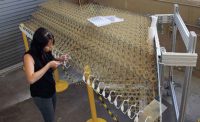AUGSBURG, Germany—Engineers at the German Aerospace Center (DLR) here have developed new materials and production methods to reduce the amount of aluminum used in airframes. Working in partnership with Airbus, Aerotec and Aernnova, DLR recently produced a multifunctional fuselage demonstrator made out of carbon-fiber reinforced thermoplastic.
The upper half of the prototype aircraft fuselage weighs 1 ton lighter than its aluminum counterpart. It was produced with new assembly technology that reduces costs and minimizes energy consumption.
The 26-foot subassembly was developed as part of the Large Passenger Aircraft Program within the European Clean Sky 2 research initiative. The goal of the R&D project is to reduce aircraft fuselage weight by 10 percent and operating costs by 20 percent.
“In order to achieve climate-friendly flight, the efficiency of current aircraft must be doubled by the middle of this century by means of lightweight system construction, among other approaches,” says Markus Fischer, Ph.D., DLR’s divisional board member for aeronautics.
To create their prototype fuselage, Fischer and his colleagues used laser-based in-situ fiber placement, continuous ultrasonic welding and electrical resistance welding.
The DLR engineers used a robot suspended upside down to produce the outer skin of the aircraft. It used a laser to precisely heat the strips of material and apply them in layers, creating a laminate of fiber-reinforced plastics.
“Material wastage is minimal, so the system is resource-efficient,” explains Fischer. “Subsequent curing in an autoclave, which is necessary for aircraft components made of carbon-reinforced composites, is no longer necessary. This shortens the production time by up to 40 percent and thus further reduces costs.”
In the next production step, the outer skin had to be fitted with longitudinal stiffeners. Instead of riveting the 44 stringers, they were ultrasonically welded onto the component. To accomplish this task, the engineers programmed a robot move along the stringers with high-precision automatic path correction.
“This method is significantly faster than the conventional mechanical process,” claims Fischer. “Like the subsequent joining technology, it boasts the advantage of producing no swarf or dust, so components can be preassembled, and the fuselage shells need not be connected together until final assembly. With metal construction, swarf could damage the hydraulics, electrics or other installations in the aircraft fuselage.”
The third technology that the DLR team has developed relates to the installation of the transverse stiffeners. The ribs were heated using an electrical current and resistance-welded using a specially developed tool. The robust process delivers high weld strengths. Since there are no holes, the load-bearing aircraft skin remains intact and dust-free.
The fuselage subassembly was recently moved to the Fraunhofer Institute for Manufacturing Technology and Advanced Materials in Stade, where it will be joined with a lower shell produced in the Netherlands to form a complete fuselage shell section by the end of this year. Airbus will then perform a final validation and verification of the technologies at the Center of Applied Aeronautical Research in Hamburg.


